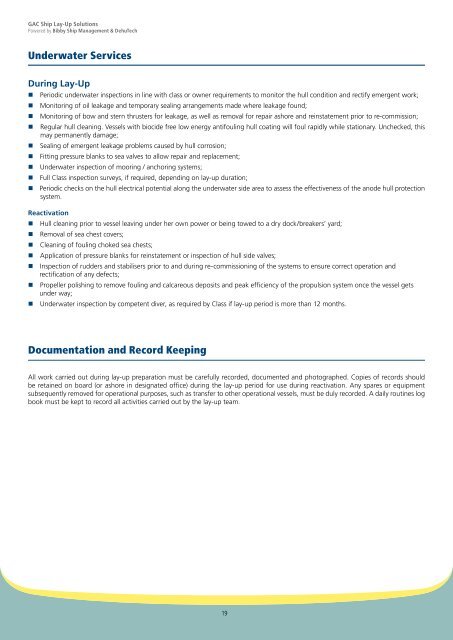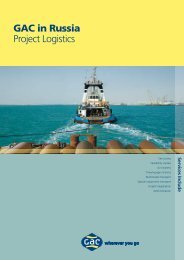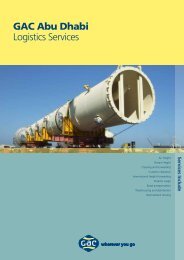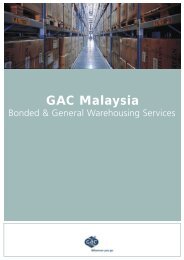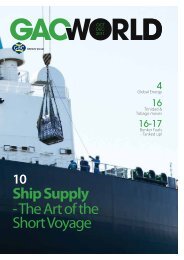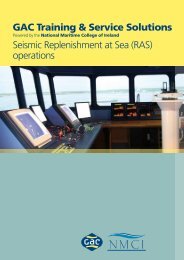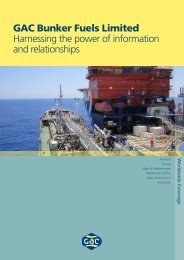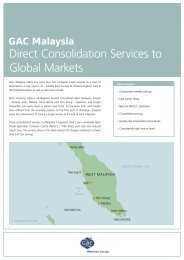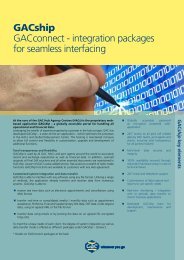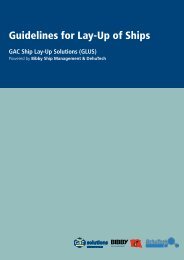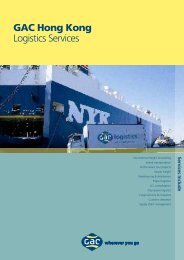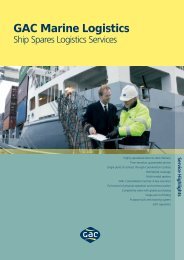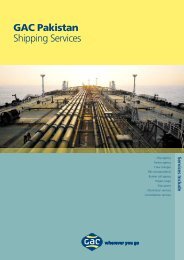Ship Lay-Up Guidelines - GAC
Ship Lay-Up Guidelines - GAC
Ship Lay-Up Guidelines - GAC
Create successful ePaper yourself
Turn your PDF publications into a flip-book with our unique Google optimized e-Paper software.
<strong>GAC</strong> <strong>Ship</strong> <strong>Lay</strong>-<strong>Up</strong> Solutions<br />
Powered by Bibby <strong>Ship</strong> Management & DehuTech<br />
Underwater Services<br />
During <strong>Lay</strong>-<strong>Up</strong><br />
n Periodic underwater inspections in line with class or owner requirements to monitor the hull condition and rectify emergent work;<br />
n Monitoring of oil leakage and temporary sealing arrangements made where leakage found;<br />
n Monitoring of bow and stern thrusters for leakage, as well as removal for repair ashore and reinstatement prior to re-commission;<br />
n Regular hull cleaning. Vessels with biocide free low energy antifouling hull coating will foul rapidly while stationary. Unchecked, this<br />
may permanently damage;<br />
n Sealing of emergent leakage problems caused by hull corrosion;<br />
n Fitting pressure blanks to sea valves to allow repair and replacement;<br />
n Underwater inspection of mooring / anchoring systems;<br />
n Full Class inspection surveys, if required, depending on lay-up duration;<br />
n Periodic checks on the hull electrical potential along the underwater side area to assess the effectiveness of the anode hull protection<br />
system.<br />
Reactivation<br />
n Hull cleaning prior to vessel leaving under her own power or being towed to a dry dock/breakers’ yard;<br />
n Removal of sea chest covers;<br />
n Cleaning of fouling choked sea chests;<br />
n Application of pressure blanks for reinstatement or inspection of hull side valves;<br />
n Inspection of rudders and stabilisers prior to and during re-commissioning of the systems to ensure correct operation and<br />
rectification of any defects;<br />
n Propeller polishing to remove fouling and calcareous deposits and peak efficiency of the propulsion system once the vessel gets<br />
under way;<br />
n Underwater inspection by competent diver, as required by Class if lay-up period is more than 12 months.<br />
Documentation and Record Keeping<br />
All work carried out during lay-up preparation must be carefully recorded, documented and photographed. Copies of records should<br />
be retained on board (or ashore in designated office) during the lay-up period for use during reactivation. Any spares or equipment<br />
subsequently removed for operational purposes, such as transfer to other operational vessels, must be duly recorded. A daily routines log<br />
book must be kept to record all activities carried out by the lay-up team.<br />
19


